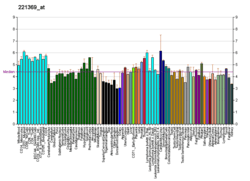Melatonin receptor 1A
Melatonin receptor type 1A is a protein that in humans is encoded by the MTNR1A gene.[5][6]
Function
This gene encodes the MT1 protein, one of two high-affinity forms of a receptor for melatonin, the primary hormone secreted by the pineal gland. This receptor is a G protein-coupled, 7-transmembrane receptor that is responsible for melatonin effects on mammalian circadian rhythm and reproductive alterations affected by day length. The receptor is an integral membrane protein that is readily detectable and localized to two specific regions of the brain. The hypothalamic suprachiasmatic nucleus appears to be involved in circadian rhythm while the hypophysial pars tuberalis may be responsible for the reproductive effects of melatonin.[6]
Ligands
- Melatonin – full agonist
- Afobazole – agonist
- Agomelatine – agonist
See also
- Melatonin receptor
- Discovery and development of melatonin receptor agonists
References
- GRCh38: Ensembl release 89: ENSG00000168412 - Ensembl, May 2017
- GRCm38: Ensembl release 89: ENSMUSG00000054764 - Ensembl, May 2017
- "Human PubMed Reference:". National Center for Biotechnology Information, U.S. National Library of Medicine.
- "Mouse PubMed Reference:". National Center for Biotechnology Information, U.S. National Library of Medicine.
- Slaugenhaupt SA, Roca AL, Liebert CB, Altherr MR, Gusella JF, Reppert SM (May 1995). "Mapping of the gene for the Mel1a-melatonin receptor to human chromosome 4 (MTNR1A) and mouse chromosome 8 (Mtnr1a)". Genomics. 27 (2): 355–7. doi:10.1006/geno.1995.1056. PMID 7558006.
- "Entrez Gene: MTNR1A melatonin receptor 1A".
Further reading
- Brzezinski A (Jan 1997). "Melatonin in humans". The New England Journal of Medicine. 336 (3): 186–95. doi:10.1056/NEJM199701163360306. PMID 8988899.
- Khan AU, Olson DL (Aug 1975). "Physical therapy and exercise-induced bronchospasm". Physical Therapy. 55 (8): 878–81. doi:10.1093/ptj/55.8.878. PMID 1144527.
- Reppert SM, Weaver DR, Ebisawa T (Nov 1994). "Cloning and characterization of a mammalian melatonin receptor that mediates reproductive and circadian responses". Neuron. 13 (5): 1177–85. doi:10.1016/0896-6273(94)90055-8. PMID 7946354.
- Witt-Enderby PA, Dubocovich ML (Jul 1996). "Characterization and regulation of the human ML1A melatonin receptor stably expressed in Chinese hamster ovary cells". Molecular Pharmacology. 50 (1): 166–74. PMID 8700109.
- Witt-Enderby PA, Masana MI, Dubocovich ML (Jul 1998). "Physiological exposure to melatonin supersensitizes the cyclic adenosine 3',5'-monophosphate-dependent signal transduction cascade in Chinese hamster ovary cells expressing the human mt1 melatonin receptor". Endocrinology. 139 (7): 3064–71. doi:10.1210/en.139.7.3064. PMID 9645677.
- Ebisawa T, Kajimura N, Uchiyama M, Katoh M, Sekimoto M, Watanabe T, Ozeki Y, Ikeda M, Jodoi T, Sugishita M, Iwase T, Kamei Y, Kim K, Shibui K, Kudo Y, Yamada N, Toyoshima R, Okawa M, Takahashi K, Yamauchi T (Sep 1999). "Alleic variants of human melatonin 1a receptor: function and prevalence in subjects with circadian rhythm sleep disorders". Biochemical and Biophysical Research Communications. 262 (3): 832–7. doi:10.1006/bbrc.1999.1308. PMID 10471411.
- Brydon L, Roka F, Petit L, de Coppet P, Tissot M, Barrett P, Morgan PJ, Nanoff C, Strosberg AD, Jockers R (Dec 1999). "Dual signaling of human Mel1a melatonin receptors via G(i2), G(i3), and G(q/11) proteins". Molecular Endocrinology. 13 (12): 2025–38. doi:10.1210/me.13.12.2025. PMID 10598579.
- Niles LP, Wang J, Shen L, Lobb DK, Younglai EV (Oct 1999). "Melatonin receptor mRNA expression in human granulosa cells". Molecular and Cellular Endocrinology. 156 (1–2): 107–10. doi:10.1016/S0303-7207(99)00135-5. PMID 10612428.
- Song CK, Bartness TJ (Aug 2001). "CNS sympathetic outflow neurons to white fat that express MEL receptors may mediate seasonal adiposity". American Journal of Physiology. Regulatory, Integrative and Comparative Physiology. 281 (2): R666–72. doi:10.1152/ajpregu.2001.281.2.R666. PMID 11448873.
- Roy D, Angelini NL, Fujieda H, Brown GM, Belsham DD (Nov 2001). "Cyclical regulation of GnRH gene expression in GT1-7 GnRH-secreting neurons by melatonin". Endocrinology. 142 (11): 4711–20. doi:10.1210/en.142.11.4711. PMID 11606436.
- Savaskan E, Olivieri G, Meier F, Brydon L, Jockers R, Ravid R, Wirz-Justice A, Müller-Spahn F (Jan 2002). "Increased melatonin 1a-receptor immunoreactivity in the hippocampus of Alzheimer's disease patients". Journal of Pineal Research. 32 (1): 59–62. doi:10.1034/j.1600-079x.2002.00841.x. PMID 11841602.
- Savaskan E, Wirz-Justice A, Olivieri G, Pache M, Kräuchi K, Brydon L, Jockers R, Müller-Spahn F, Meyer P (Apr 2002). "Distribution of melatonin MT1 receptor immunoreactivity in human retina". The Journal of Histochemistry and Cytochemistry. 50 (4): 519–26. doi:10.1177/002215540205000408. PMID 11897804.
- Ayoub MA, Couturier C, Lucas-Meunier E, Angers S, Fossier P, Bouvier M, Jockers R (Jun 2002). "Monitoring of ligand-independent dimerization and ligand-induced conformational changes of melatonin receptors in living cells by bioluminescence resonance energy transfer". The Journal of Biological Chemistry. 277 (24): 21522–8. doi:10.1074/jbc.M200729200. PMID 11940583.
- Yuan L, Collins AR, Dai J, Dubocovich ML, Hill SM (Jun 2002). "MT(1) melatonin receptor overexpression enhances the growth suppressive effect of melatonin in human breast cancer cells". Molecular and Cellular Endocrinology. 192 (1–2): 147–56. doi:10.1016/S0303-7207(02)00029-1. PMID 12088876.
- Slominski A, Pisarchik A, Zbytek B, Tobin DJ, Kauser S, Wortsman J (Jul 2003). "Functional activity of serotoninergic and melatoninergic systems expressed in the skin". Journal of Cellular Physiology. 196 (1): 144–53. doi:10.1002/jcp.10287. PMID 12767050.
- Morcuende JA, Minhas R, Dolan L, Stevens J, Beck J, Wang K, Weinstein SL, Sheffield V (Sep 2003). "Allelic variants of human melatonin 1A receptor in patients with familial adolescent idiopathic scoliosis". Spine. 28 (17): 2025–8, discussion 2029. doi:10.1097/01.BRS.0000083235.74593.49. PMID 12973153.
- Aust S, Thalhammer T, Humpeler S, Jäger W, Klimpfinger M, Tucek G, Obrist P, Marktl W, Penner E, Ekmekcioglu C (Jan 2004). "The melatonin receptor subtype MT1 is expressed in human gallbladder epithelia". Journal of Pineal Research. 36 (1): 43–8. doi:10.1046/j.1600-079X.2003.00095.x. PMID 14675129.
This article is issued from Wikipedia. The text is licensed under Creative Commons - Attribution - Sharealike. Additional terms may apply for the media files.




